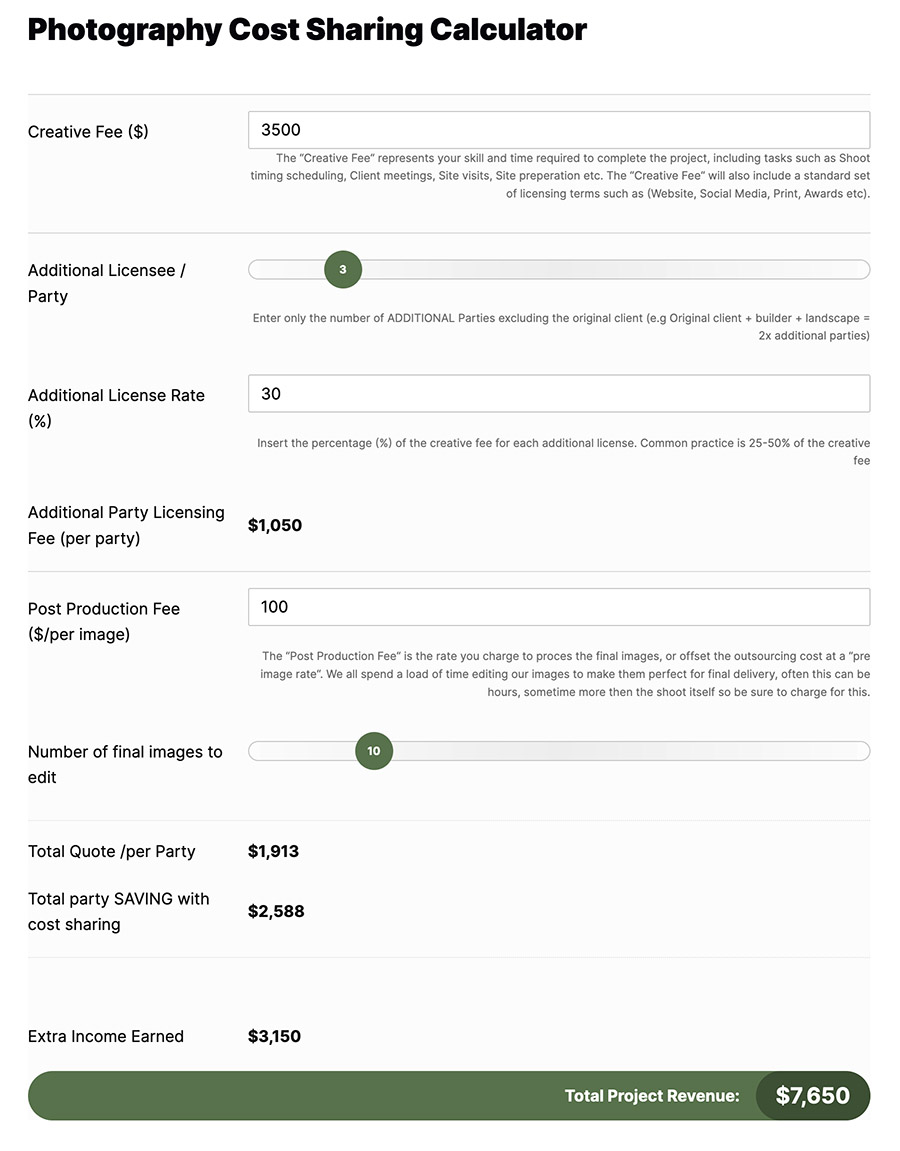Take the Guess Work Out of Cost Sharing With This Genius Pricing Calculator by Aaron Radford
Let’s talk about making money. The most common questions in the APALMANAC inbox are about pricing. Pricing architecture and interior photography can be nuanced and chock full of variables like usage, licensing, creative fees, post-production fees, assistant charges, and the like.
One such aspect of pricing is a magical little thing called cost sharing.
Cost sharing is an extremely powerful pricing tool that provides a win-win for both you and your clients. It is a pricing and licensing option where a photographer photographs a space, and then distributes images to multiple parties involved in the project who have “gone in” on the shoot together. Simply put, it brings the overall cost of the project down for all of the hiring parties involved, but brings the revenue for you – the photographer – up for doing essentially the same amount of work.
Sounds awesome right? So how do you do it? Cost sharing, like any pricing any job, requires a bit of foresight and for you to have established rates.
Hamilton, NZ based architectural photographer Aaron Radford shares “Like many of us, I started photographing real estate and the pricing structure for that is very different from charging for an architectural shoot. I always battled when quoting for architectural and commercial shoots and was constantly undercharging due to not having a proper pricing method. Then when a third party asked for images I was either giving them away for free or coming up with a price on the spot.”
If that sounds familiar to you, you’re not alone. Let’s face it, many artistes aren’t fond of math. If you’re anything like me – and Aaron – you probably wish that there was a magic generator that you could just plug some prices and percentages into and it would spit out a number for you…
That’s exactly what Aaron has created with his genius Cost Sharing Calculator.

Aaron’s pricing calculator gives you the ability to quickly input your day rate/creative fee, post-processing fee, and additional license rate. From there, you can slide around variables like the number of parties involved, and number of images you’re going to be delivering. Once you have everything set up just so, the calculator generates your total project revenue, while breaking down each licensee’s quote, as well as showing how much each party saves. Pretty cool, eh?
Since introducing cost sharing in his business and educating his clients on how it works and benefits them, Aaron estimates that about 70-80% of his jobs are cost shared. His business has benefitted from “an increase in revenue client base, by turning one potential client into 3 or 4, and more often than not the additional parties will eventually hire me for their own shoot on different projects.”
I love the idea of cost sharing because it is beneficial for everyone involved. On the flip side though, you need to put some caveats and limitations in the cost share agreement to set expectations and head off any issues. I asked Aaron his take on this, and he said:
“Yes totally!
Say you have a lighting company for example that may require specific details, you do need to plan the shoots to not miss shots for a particular client. eg, you may be a LIGHTS OFF shooter but the lighting company has specialty lighting in all rooms you will need to plan for that.
When on-site I only usually have the initial client and a stylist or interior designer to eliminate “too many cooks in the kitchen.”
You can – and should – check out Aaron’s pricing calculator here:
If you’re on the hunt for more information about pricing your architecture photography and using cost sharing with your clients, I’d also highly recommend reading Mike Kelley’s cost sharing article here on APALMANAC, and giving “Pricing Your Photography” from The Business of Architecture Photography a watch! Now go forth and make money!
